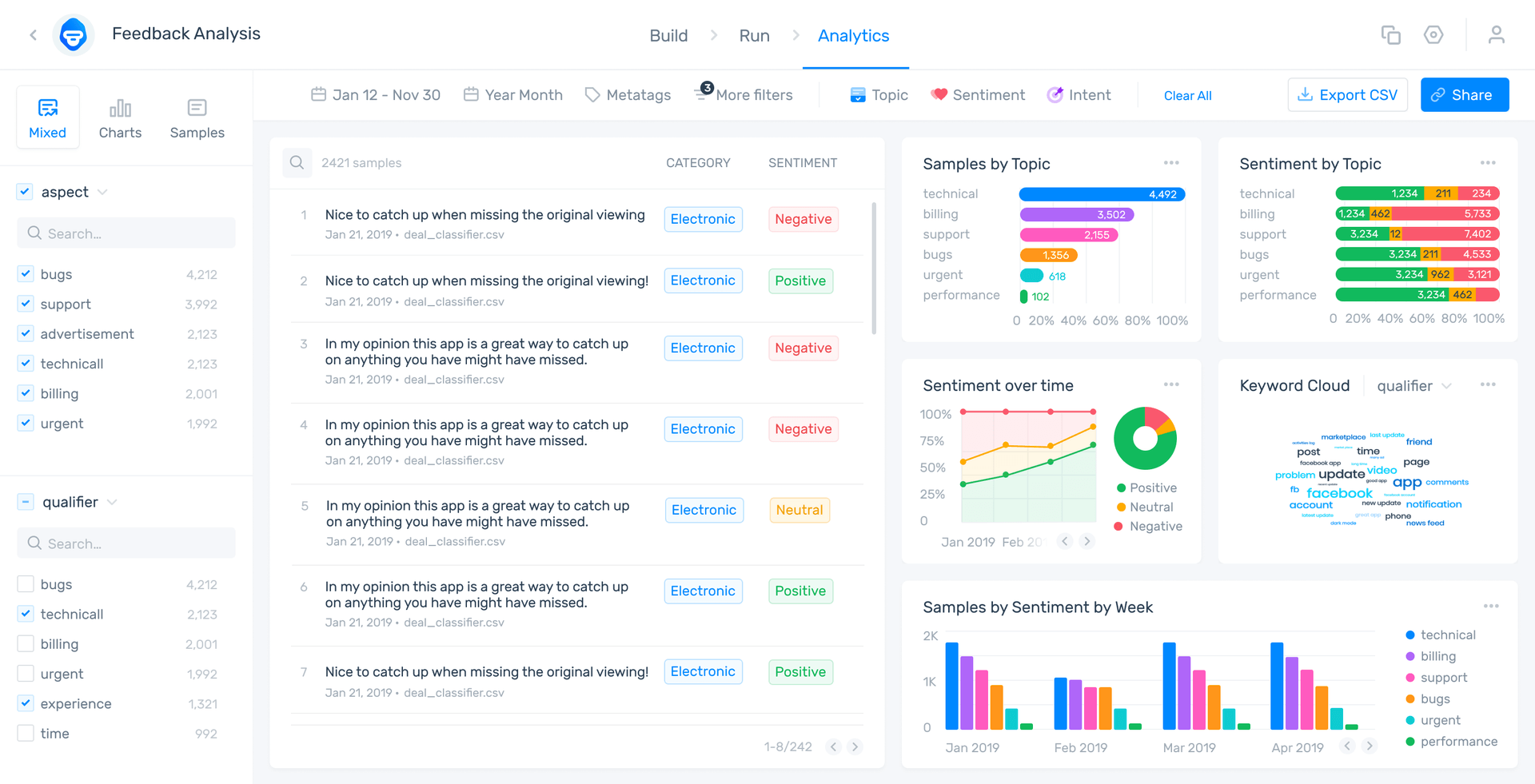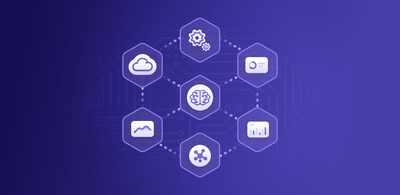Introducing Augmented Analytics & How It Benefits Businesses

With advancements in technology and growth in data mining, data discovery, and data storage, come greater AI data analysis capabilities. New techniques are making data analytics faster, easier, and even more powerful.
One of the top data analytics trends for 2022, augmented analytics, came out of studies at global IT research firm, Gartner, and is regularly listed as one of their top data analysis trends.
Augmented analytics is a concept that is sure to grow in the years to come, as AI and machine learning become more intertwined in our everyday lives.
But just exactly what is a good definition of augmented analytics?
- What Is Augmented Analytics?
- Augmented Analytics Benefits
- Augmented Analytics Examples
- Augmented Analytics Challenges
What Is Augmented Analytics?
Augmented analytics, a term that was coined in a 2017 Gartner research paper, is a method of data analytics that uses AI machine learning and natural language processing (NLP) to prep data and automate analysis procedures that would have previously been done manually.
Augmented analytics saves huge amounts of time and reduces manual processes, using around-the-clock automatic data preparation techniques to anticipate a user or analyst’s needs and “augment” data analysis with AI and machine learning techniques.
It’s used in business intelligence (BI) and analytics platforms to facilitate data collection, data cleaning, and insight generation with machine learning-augmented analysis processes, to automate insights and help make better data-driven business decisions.
The use cases and benefits of augmented analytics technologies can be huge for any business.
Augmented Analytics Benefits
The top 5 benefits of augmented analytics:
- Accelerates data gathering and preparation
- Delivers value faster
- Deeper data analysis
- Helps democratize data analytics
- Scalable and more accurate analysis
Accelerates data gathering and preparation
Augmented analytics tools can be trained to automatically gather and clean data in order to prepare it for analysis. This process generally still requires assistance from data scientists in order to teach machine learning algorithms the kinds of data needed and the initial processes for cleaning and structuring the data.
But once they are trained, the algorithms can be set loose on massive amounts of data to save businesses hundreds of tedious hours of cleaning and prep time. This is especially useful considering that data scientists still spend about 45% of their time on data preparation.
Automatic data profiling, for example, can find similar datasets, then label and annotate them in real time, so they’re ready to go for all manner of analysis. They’ll only push to manual preparation when an unknown profile has come through the pipeline.
When you have regular forms of data and perform a set number of analyses, your analysis can be set up so that you only receive fully cleaned, prepared, and annotated data on a regular basis.
Advancements in natural language processing have given analysis platforms the ability to comprehend written or spoken human language instantaneously. A process that could have taken days or weeks, just a few years ago.
Delivers value faster
Faster, automatic data preparation means faster results and frees up your employees to spend their time on more important tasks, like using analysis results to find new insights and make data-driven decisions.
Augmented analytics streamlines every step of the analysis process by leveraging machine learning algorithms to automate repetitive tasks and get you from data gathering to striking visualization in a single, seamless process.
BI tools, like MonkeyLearn Studio, for example, allow you to custom-train text analysis tools, set them up to work in concert, then let augmented analytics take over 24/7 and in real time.
The below shows a MonkeyLearn Studio analysis of reviews of Zoom.

The reviews are separated into classification categories (Usability, Reliability, etc.), then are broken into sentiment (positive, neutral, negative) by category. This, ultimately, allows you to understand which aspects of your business are most positive and which are most negative. Augmented analytics means this analysis can run constantly, start to finish, with very little human interaction needed.
Deeper data analysis
Instituting AI algorithms at every step of the analysis process, means more computing power with fewer resources. With the tedium out of the way, your analysts can focus on deeper examinations of their data. Once augmented analytical systems have been taught how to react to any given process, you won’t have to oversee that process again in the future.
Deep learning NLP algorithms can read text for nuance, just like humans. However, because they only react to data they were trained on, they don’t make subjective mistakes like humans.
Helps democratize data analytics
Augmented analytics and the rise of SaaS analysis platforms, like MonkeyLearn, make powerful artificial intelligence and machine learning available to everyone. Modern SaaS analysis platforms perform just as fast and just as accurately as the most expensive, in-house data analysis systems. And the beauty of SaaS means you only pay for what you use.
Scalable and more accurate analysis
Augmented analytics SaaS platforms are generally run in the cloud, so they're completely scalable, and once you’ve trained tools to the needs and criteria of your business, they perform much more accurately than humans ever could.
Now that you’ve seen how augmented analytics can benefit your business, let’s take a look at some examples of augmented analytics in practice.
Augmented Analytics Examples
Top augmented analytics use cases:
- Advanced personalization in e-commerce
- Product feedback analysis
- Survey analysis
- Dynamic pricing
Advanced personalization in e-commerce
The speed and ease with which augmented analytics discovers patterns in data can be a huge boon to e-commerce personalization. E-commerce and online advertising platforms already gather copious data on customers. Now it’s time to leverage that data, because the more you know about your customers, the better you’ll be able to serve them.
E-commerce platform, Barilliance, estimates that increased personalization and product recommendations can increase a buyer’s average number of cart items by a whopping 68.14%. Augmented analytics allows retailers to track online behavior across multiple platforms – web browser, mobile, apps, etc. – to integrate, automatically analyze, and act on all this data to better serve your customers and increase conversion rates by up to 320%.
Product feedback analysis
Augmented analysis platforms, like MonkeyLearn, can streamline product feedback analysis, so you can request product feedback in surveys, analyze regular customer service feedback, or mine customer product feedback from social media or online reviews.
Setting up a customer feedback loop will ensure that you’re always gathering relevant feedback, automatically analyzing it, and using it to constantly improve your products and/or services.
Survey analysis
Augmented analysis can integrate survey tools, like Google Forms, Typeform, and SurveyMonkey with text analysis and BI platforms, like MonkeyLearn Studio, to automate results. You only have to train the tools to your needs and criteria, and you’ll get your real-time results and striking visualizations.
For example, Dell saved hundreds of hours on survey analysis by using MonkeyLearn’s aspect-based sentiment analysis to understand employee opinions about various aspects of their work environments. Dell analyzed 10,000 comments in just a week (a process that previously took months) and routed valuable information to the appropriate managers right away for instant implementation.
Dynamic pricing
Dynamic pricing allows retailers to change product pricing according to supply and demand. Augmented analytics can make this process automatic by following data across industries, regions, and markets. As the market changes, so do your prices.
Joining dynamic pricing with e-commerce personalization allows you to go one step further and gauge an individual customer’s price tolerance, so you can make an educated prediction of the best price to charge and know when to change it. Amazon, for example, has become an expert in dynamic pricing by realizing that, if one customer may pay only half what another would pay for the same product, it still may be worth the sale.
Augmented Analytics Challenges
Although augmented analytics quite clearly offers a number of great benefits to businesses, there are still some challenges you should be aware of, so you can institute workarounds or cover blind spots. Augmented analytics is still a new concept, so some of the kinks have yet to be worked out and challenges overcome.
Data cleaning – Depending on your goals and what kind of data you’re working with, it’s important you follow best practices for data cleaning. Augmented analytics is only as “smart” as the programs and algorithms it uses have been trained, so you can’t assume it will automatically work right away. Put some time into research for the best course of action.
Training tools with appropriate training data takes time and should be done correctly – Similar to the above, you’ll need to learn about best practices for training your models. The more augmented analytics models are trained, the smarter they’ll become. If you’re learning about customer support ticket tagging best practices, you’ll need to design an appropriate hierarchy of subtags and choose tags that can be used consistently, among other things. Once your ticket tagging models are trained properly, they’ll automatically route for urgency and importance to the correct department and employee. But you need to put the training time in.
Scaling up requires more computer power – Although the mathematical prowess of augmented analytics machine learning algorithms allows you to do more with less computing power, if you’re going from analyzing hundreds of text samples a day to thousands or hundreds of thousands, you’ll need to plan ahead with greatly scaled computing architecture.
Put Augmented Analytics to Work for You
Despite some of its limitations due to growing pains and the need for heavy training, augmented analysis can be used to great effect for nearly any business that has large (or small) amounts of data to be analyzed.
Natural Language Processing allows you to communicate in plain English (or many other languages) with analysis programs, and augmented analytics automatically prepares data to streamline processes and anticipate your needs. It’s clear that it’s important, but where do you get started?
MonkeyLearn’s powerful text analysis tools are a great place to start (and very likely can provide everything you need) with augmented analytics. You’ll be amazed at what text analysis tools, like sentiment analysis, topic classification, and urgency detection can do for your business.
Sign up to MonkeyLearn to try the tools right now for free. Or schedule a demo to see all the augmented analytics tools MonkeyLearn has to offer.

Inés Roldós
February 16th, 2021






